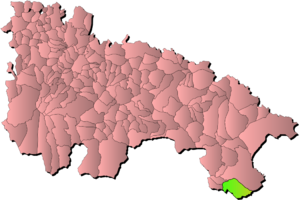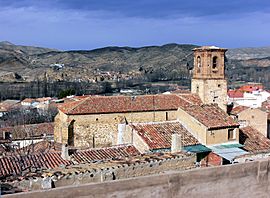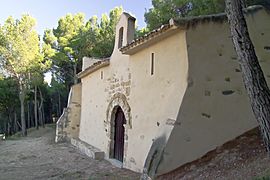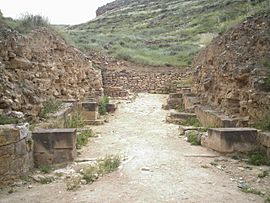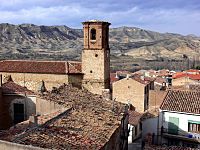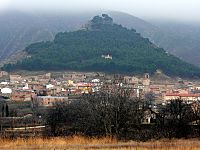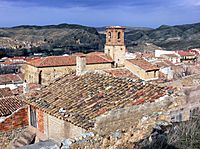Aguilar del Río Alhama facts for kids
Quick facts for kids
Aguilar del Río Alhama
|
|
|---|---|
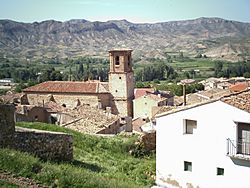
Panoramic view of the village and the Asunción church
|
|
 |
|
| Country | |
| Autonomous community | |
| Comarca | Cervera |
| Area | |
| • Total | 54.11 km2 (20.89 sq mi) |
| Elevation | 642 m (2,106 ft) |
| Population
(2018)
|
|
| • Total | 470 |
| Postal code |
26530
|
| Website | Aguilar del Río Alhama |
Aguilar del Río Alhama is a small village in La Rioja, Spain. It is a part of the autonomous community of La Rioja. The village is located in a low mountain area, at the base of the Iberian System. It covers about 54 square kilometers. As of 2018, around 470 people live there. The Alhama river flows through the area.
Contents
Where is Aguilar del Río Alhama?
This village is in the very southeast part of La Rioja. It sits near the Sierra del Pelago mountains.
It shares borders with several other towns:
- To the north and east, it borders Cervera del Rio Alhama.
- To the west, it borders Valdemadera and Navajún.
- To the south, it borders four towns in Soria province: Cigudosa, San Felices, Dévanos, and Ágreda.
A Look at History
The first time Aguilar del Río Alhama was mentioned was in the 12th century. It became part of Castile in 1198.
In 1269, Theobald II of Navarre gave the village the right to have a weekly market. This market was held every Tuesday. Later, in 1271, Henry I of Navarre ordered people from a nearby village called Rio to move here. This helped to make Aguilar del Río Alhama a single, larger community.
In the 14th century, the village became part of the Cameros lordship. In 1452, John II of Castile removed a special tax on wine for the people of Aguilar. He did this because they had been loyal to him.
The Aguilar County was created in the 16th century. For a long time, many people in Aguilar del Río Alhama were Moriscos. These were Moors who had been forced to become Catholic. In the late 1500s, many Moriscos from the village faced harsh treatment. They were accused of secretly practicing Islamic rituals. Later, in the early 1600s, all Moriscos were ordered to leave Spain.
In 1747, a small mine was found in an area called Santo de la Peña. People dug out some materials there and sold them to potters.
Dinosaur Footprints
Millions of years ago, during the Cretaceous period, the area where Aguilar del Río Alhama is now was a muddy plain. Dinosaurs walked across this mud, leaving their footprints behind. Over time, these footprints dried and were covered by new layers of sediment. This sediment turned into rock. Now, erosion has worn away the top layers, showing these ancient dinosaur tracks.
One special place is "La Virgen del Prado." It was named a Historic Site in 2000. It is close to the village of Inestrillas. Here, you can find 36 footprints from meat-eating dinosaurs. These footprints are about 30 to 32 centimeters long. Some form a small trail, while others are separate. The footprints in Aguilar del Río Alhama are the oldest found in La Rioja. Scientists have also found fish scales from the Lepidotes fish here.
Population Changes
In 1959, a textile factory in the village closed down. This caused many people to leave Aguilar del Río Alhama to find work elsewhere. This led to a fast drop in the number of people living there.
On January 1, 2010, the total population was 573 people.
| Vertical bar chart demographic of Aguilar del Río Alhama between 1857 and 2010 |
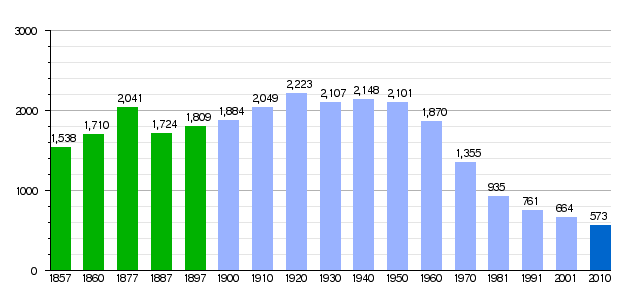 |
| Legal population (1857-1897) according to the population census published by the Instituto Nacional de Estadística in the 19th century.
Legal population (1900-1991) or Resident population (2001) according to the population census published by the Instituto Nacional de Estadística. Population according to the municipal register of 2010 published by the Instituto Nacional de Estadística. |
Population of the Main Village
As of January 1, 2010, the main village of Aguilar del Río Alhama had 493 residents.
| Vertical bar chart demographic of Aguilar del Río Alhama between 2000 and 2010 |
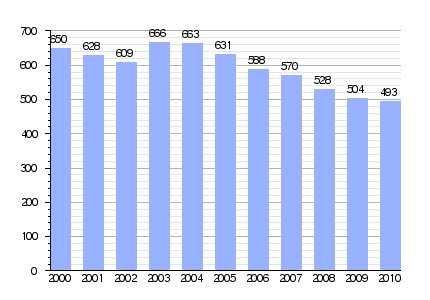 |
Population by Village Part
| Nucleus | Inhabitants (2000) | Inhabitants (2010) |
|---|---|---|
| Aguilar del Río Alhama | 650 | 493 |
| Inestrillas | 37 | 80 |
Getting Around
You can reach Aguilar del Río Alhama using different roads:
- County road 284 connects Aguilar to Cervera del Río Alhama. The village of Inestrillas is also on this road.
- Route 388 goes to the Soria towns of San Felices and Castilruiz.
- Route 490 connects to Valdemadera and Navajún.
There are also bus services from:
Cool Places to Visit
Buildings and Old Structures
- Church of the Assumption: This church was built in the 16th century. It has a single main room with beautiful vaulted ceilings. Inside, you can see altarpieces from the Neoclassical and Baroque styles. There is also an old Gothic sculpture of the Virgen de los Remedios.
- The Valvanera or Santa María La Antigua Hermitage: This is an old chapel from the Romanesque period.
- Castle: The ruins of an old castle can be found on top of a hill next to the village. It was built in the 12th century.
Other Interesting Spots
- Contrebia Leukade: This was an ancient Celtiberian city. Its history goes back to the early Iron Age. You can still see its well-preserved ruins. It is very close to the village of Inestrillas.
- Gutur: This is a deserted village. It has a chapel dedicated to the Virgen de los Remedios.
Animals and Plants
You can often see many vultures flying high above the town. Golden eagles, Bonelli's eagles, and hawks also live here. The European polecat (a type of weasel) can be found too.
The area has common trees like oak and elder. You can also find special trees like the turpentine tree, black maple, and different types of juniper. White rockrose plants also grow here.
Local Celebrations
- January 17: San Antón.
- May 3: Day of the Cross. This celebration is now held on the first Saturday in May. People make a pilgrimage to the shrine of the Virgen de los Remedios in Gutur. A traditional food called "Bodigos" (bread filled with egg and sausage) is eaten on this day.
- August 14 to 20: These are the main festivities. They honor the Assumption and Saint Roch.
Image gallery
- Views of Aguilar
See also
 In Spanish: Aguilar del Río Alhama para niños
In Spanish: Aguilar del Río Alhama para niños




